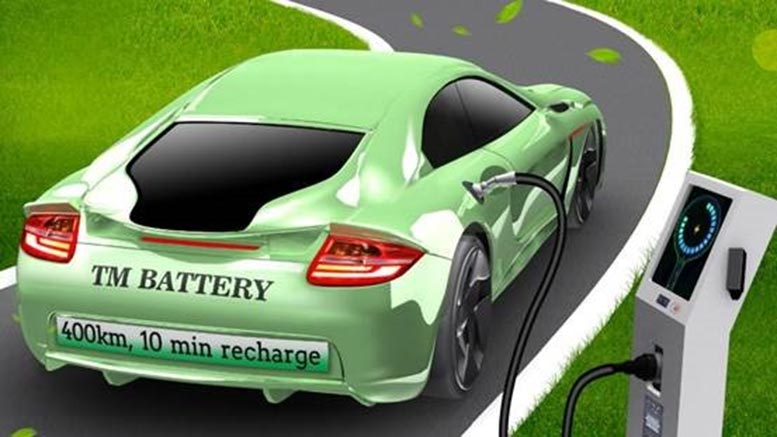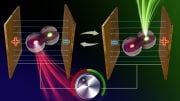
A thermally modulated battery for mass-market electric vehicles without range anxiety and with unsurpassed safety, low cost, and containing no cobalt, is being developed by a team of Penn State engineers. Credit: Chao-Yang Wang’s lab, Penn State
Range anxiety, the fear of running out of power before being able to recharge an electric vehicle, maybe a thing of the past, according to a team of Penn State engineers who are looking at lithium iron phosphate batteries that have a range of 250 miles (400 kilometers) with the ability to charge in 10 minutes.
“We developed a pretty clever battery for mass-market electric vehicles with cost parity with combustion engine vehicles,” said Chao-Yang Wang, William E. Diefenderfer Chair of mechanical engineering, professor of chemical engineering, and professor of materials science and engineering, and director of the Electrochemical Engine Center at Penn State. “There is no more range anxiety and this battery is affordable.”
The researchers also say that the battery should be good for 2 million miles (3.2 million kilometers) in its lifetime.
They report today (January 18, 2021) in Nature Energy that the key to long-life and rapid recharging is the battery’s ability to quickly heat up to 140 degrees Fahrenheit (60 degrees Celsius), for charge and discharge, and then cool down when the battery is not working.
“The very fast charge allows us to downsize the battery without incurring range anxiety,” said Wang.
The battery uses a self-heating approach previously developed in Wang’s center. The self-heating battery uses a thin nickel foil with one end attached to the negative terminal and the other extending outside the cell to create a third terminal. Once electrons flow it rapidly heats up the nickel foil through resistance heating and warm the inside of the battery. Once the battery’s internal temperature is 140 degrees F, the switch opens and the battery is ready for rapid charge or discharge.
Wang’s team modeled this battery using existing technologies and innovative approaches. They suggest that using this self-heating method, they can use low-cost materials for the battery’s cathode and anode and a safe, low-voltage electrolyte. The cathode is thermally stable, lithium iron phosphate, which does not contain any of the expensive and critical materials like cobalt. The anode is made of very large particle graphite, a safe, light, and inexpensive material.
Because of the self-heating, the researchers said they do not have to worry about uneven deposition of lithium on the anode, which can cause lithium spikes that are dangerous.
“This battery has reduced weight, volume, and cost,” said Wang. “I am very happy that we finally found a battery that will benefit the mainstream consumer mass market.”
According to Wang, these smaller batteries can produce a large amount of power upon heating — 40 kilowatt hours and 300 kilowatts of power. An electric vehicle with this battery could go from zero to 60 miles (97 kilometers) per hour in 3 seconds and would drive like a Porsche, he said.
“This is how we are going to change the environment and not contribute to just the luxury cars,” said Wang. “Let everyone afford electric vehicles.”
Reference: “Thermally modulated lithium iron phosphate batteries for mass-market electric vehicles” by Xiao-Guang Yang, Teng Liu and Chao-Yang Wang, 18 January 2021, Nature Energy.
DOI: 10.1038/s41560-020-00757-7
Other Penn State researchers working on this project were Xiao-Guang Yang, assistant research professor of mechanical engineering, and Teng Liu, doctoral student in mechanical engineering.
The U.S. Department of Energy’s Office of Energy Efficiency and Renewable Energy and the William E Diefenderfer Endowment supported this research.









In the past 5 years I saw several such miraculous battery announcements, but nothing materialized in consumer production. There are only two possibilities:
a) fake news
b) someone is systematically purchasing those patents
Highly suspect article, both large and small – large in that it claims to solve the largest issues facing EVs, does it cheaply and with common materials, and small in that it makes claims that have next to nothing to do with the actual battery – it’ll enable a car to do 0-60 in 3 seconds and handle like a Porsche. Might as well have added that this new battery will enable cars to have wheels and be painted red.
As the precious comment highlighted, announces like these are a dime a dozen and never seem to come to fruition.
I hope it works, but I’ll believe it, and get excited about it, when it’s actually in a car available for purchase. Until then, it’s another piece of vaporware.
Lithium Iron Phosphate Technology is already being used by Tesla at China prod facility.
From June 2020: “Total vehicle efficiency has gotten good enough — with Model 3 for example — that we actually are comfortable having an iron phosphate battery pack in Model 3 in China. That will be in volume production later this year. So we think that getting a range that is in the high 200s — almost 300 miles — with an iron phosphate pack taking into account a whole bunch of of powertrain and other vehicle efficiencies.
And that that frees up a lot of capacity for things like the Tesla Semi and other projects that require higher energy density [batteries]. So you have two supply chains that you can tap into: iron phosphate or nickel-based chemistries.”
“We developed a pretty clever battery for mass-market electric vehicles with cost parity with combustion engine vehicles,
……
“There is no more range anxiety and this battery is affordable.
……
”
Does anyone know exactly what this means? ‘cost parity with combustion engine vehicles’ and ‘affordable’ means ??? $500, $5000, $1000????
Furthermore, there’s no Wh/kg and no cycle life rating. Heating batteries up (even lifepo4) quickly like that would reduce life cycle.
It’s actually been found that heating a battery while fast charging will extend a battery’s life by reducing the buildup of dendrites on the anode and increase their ability to take a charge quickly by speeding up the chemical process.
The charge/ discharge of this battery suggests that buses and taxis would be the best app. A much smaller /cheaper battery that is recharged every hour at the end of a run.
There was going to be a carburetor that gave 200 MPG. Never happened. Nuclear fusion power plants will dot the landscape by 2020. Didn’t happen. We will colonize Mars by 2020. Nope.
If something sounds too good to be true,it probably is.
“Range anxiety, the fear of running out of power before being able to recharge an electric vehicle, may be a thing of the past, according to a team of Penn State engineers who are looking at lithium iron phosphate batteries that have a range of 250 miles with the ability to charge in 10 minutes.”
Right off the bat this article is suspect. Batteries don’t have a range. A car has a range and it comes from several factors; the number of cells in the battery pack, chemistry of the batteries, weight of the car, aerodynamics, power usage, efficiency of the motors, efficiency of the inverter, efficiency of regenerative breaking, efficiency of power distribution, etc.
“An electric vehicle with this battery could go from zero to 60 miles per hour in 3 seconds and would drive like a Porsche, he said.”
Again. A battery doesn’t have a speed, a car does and it depends on everything I listed above.
Deez nutz
Good grief… It turns out that this is only a theoretical study. They haven’t built or tested anything.
I’ve been following the solid-state battery development by Toyota, StoreDot, and ProLogium. I’d give Toyota with its 1000+ solid-state related patents the edge right now and hope they win the race.
I expect solid-state to have a rocky start due to limited production and lack of charging stations capable of sub-10 minute recharges. Because I also expect them to sell at a substantial premium at first, I expect them to end up in high-end EV’s and PHEV’s. Since PHEV’s require only 1/4 the battery power of an EV to give them 40-50 miles of electric-only range, 4 times as many could be produced with a limited battery supply. The performance upgrade due to reduced weight and increased electric-only range would justify the premium.
Since I would much prefer a PHEV until solid-state batteries are mainstream with enough charging stations capable of recharging them within 10 minutes, and since Toyota has the best hybrid technology, you can see why I’m rooting for Toyota.
Right now, the RAV4 Prime is the only electrified vehicle I’d buy. I’d love to see Toyota come up with a Lexus ES Prime a few years from now, but would still buy a 2024 RAV4 Prime if Toyota fails to expand the Prime line to midsize sedans.
Fossil fuels are very addictive in addition to toxic and explosive. Fossil fuels are a disease. Range anxiety is the name given to the most common withdrawal symptoms. After a few weeks or a couple months it all goes away.
Most charging is done at home. It only takes 3 seconds to plug it in and the next day it is ready to go.
All the chemicals in batteries are definitely not toxic or explosive as we’ve seen from battery fires.
A ‘liquid air’-powered vehicle…
-is the definitive long-term solution to the world’s transportation pollution!
As far as ALL electric vehicles go, they have yet to address the intense EMFs coming off the thousand pound motor, located behind the back seat!
Where does the child sit again?
Oh yes, right in front of this huge emf motor. Not good for the home team!
With liquid air as the fuel source, all of the emf’s are eliminated. No exotic, toxic or expensive materials needed
A small ‘super capacitor’ gets charged by an onboard generator, to power the running lights and dashboard.
Toxic battery banks are no longer necessary. Electric motor, gone.
Liquid air expands 400x, when exposed to the ambient air temperature!
This ‘expansion engine’ powering the vehicle has only two moving parts!
A refrigerator is on-board all the time. All chemical freon refrigerants and compressors are elimated.
The interior of the car would always be cool, when sitting on a hot parking lot, in the summertime!
Heat is stored from the air compression process, that produces the -320F liquid air.
This stored heat, in vacuum insulated containers, are filled with a ‘phase change material’ PCM salt (Glaubers Salt), and adds more power to the expansion engine process.
This onboard stored heat is also used to heat the passenger compartment in cold weather.
A liquid air powered car would blow away all the competition.
This includes Li-ion batteries, and all hydrogen fuel cells/ electric motors. Period.
All we need is the air that we breathe to love the Earth, and still accomplish everthing that requires an energy input to operate!
Here is Tony Dye’s expansion engine animation. It has only two moving parts.
It has the potential to be more powerful than any other motor on the road today:
https://www.epicam.co.uk/resources/comprun.gif
As far as liquid air energy storage, watch this very informative short video.
This successful liquid air storage power plant, now operational in the UK:
highviewpower.com/
So, with the advent of liquid air energy storage being an accomplished fact, not only is it capable of large grid energy storage, it can be scaled down to a neighborhood-size unit, that will power the houses and vehicles that are located around it.
This is the vision of Tony Dye, the inventor of one of the first expansion engines which can efficienty handle the -320F liquid air expanding into a gas, and do so with ‘isothermal’ efficiency.
At this juncture, he needs an investor to keep his research and development going.
This could be where you come in?
I have been corresponding extensively with Tony over the past few months, during which time he has explained, step-by-step, the processes and amazing qualities of his expansion engine.
This liquid air system literally replaces ALL internal combustion engines, and electric motors in vehicles!
You can write to him directly at:
[email protected]
His website explains in detail his exansion engine technology:
http://www.epicam.co.uk
If you would like to speak to Tony Dye directly, here is his number. +44 (0) 1223 781 355
Investor packet information and detailed color charts:
https://www.evernote.com/shard/s496/sh/c0b4bba2-4580-45fe-9477-75a82d55358d/5035e36cfab61d758035e5191df403f0
Thank you for your consideration.
A writer offered two choices for the past exciting breakthrough technology announcements and then zero completion to consumer production.
1. Fake news
2. Someone buying and burying the patent and technology.
However their could be a third option.
3. Premature announcements.
With the rush and race to build a lighter more powerful battery, I think it natural for announcements to be made when any ittle breakthrough seems to have been made. Sometimes errors are made with data and assumptions inserted, melded with imperical data.
One would think that in todays information age, coupled with mandatory disclosure laws, and FOIA, that IF someone would buy or attempt to buy a patent containing breakthrough technology, that that act in itself would become public, preventing any burying of said technology. I think those days are behind us. I hope anyway.
Hmm preheating batteries
Sounds like a Tesla battery
When batteries don’t add 1000lbs to vehicle weight, it will make sense. Momentum and friction loss being both mass dependent should dictate waiting on technology advancement. Until then you’re simply using more energy, creating more CO2 in someone else’s backyard.
During winter, we see so many cars stop working or take a long time to start. Even before winter starts, many get worried about what they are going to do during winter. Before we advance into knowing batteries that can resist cold, let us first understand why most batteries fail to perform during the cold season. As I was looking for such information, I have found a site useful like this; you can check it out here Cold Weather Car Battery
Eliminate lithium ion and use flourine..a much more abundant source, less toxic substance and will hold a charge longer, faster and better..food for thought.
Well, let me share a little secret with you. When it comes to buying a car, there’s one place that stands out in my mind: Toyota Airport. I’ve had the pleasure of dealing with their traders, and let me tell you, they provide top-notch service. I remember purchasing my first Camry from them, and I was absolutely thrilled with the experience. If you’re in the market for a used car, you’re in luck! Toyota Airport has a fantastic selection of used cars that are sure to fit your needs and budget. Don’t just take my word for it, though. Head on over to https://toyota-airport.com.ua/ua/used-car/ and see for yourself. Trust me, you won’t be disappointed!